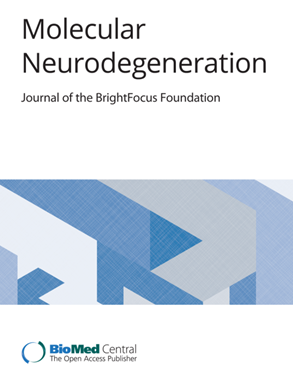β-Amyloid induces microglial expression of GPC4 and APOE leading to increased neuronal tau pathology and toxicity
IF 17.5
1区 医学
Q1 NEUROSCIENCES
引用次数: 0
Abstract
To define how Aβ pathology alters microglia function in Alzheimer’s disease, we profiled the microglia surfaceome following treatment with Aβ fibrils. Our findings reveal that Aβ-associated human microglia upregulate Glypican 4 (GPC4), a GPI-anchored heparan sulfate proteoglycan (HSPG). Glial GPC4 expression exacerbates motor deficits and reduces lifespan in a Drosophila amyloidosis model, implicating GPC4 in a toxic neurodegenerative program. In cell culture, GPC4 enhances microglia phagocytosis of tau aggregates, and shed GPC4 can act in trans to facilitate tau aggregate uptake and seeding in neurons. Additionally, our data demonstrate that GPC4-mediated effects are amplified in the presence of APOE. In human Alzheimer’s disease brain, microglial GPC4 expression surrounding Aβ plaques correlates with neuritic tau pathology, supporting a pathological link between amyloid, GPC4, and tau. These studies define a mechanistic pathway by which Aβ primes microglia to promote tau pathology via HSPGs and APOE.β-淀粉样蛋白诱导GPC4和APOE的小胶质表达,导致神经元tau病理和毒性增加
为了确定Aβ病理如何改变阿尔茨海默病中的小胶质细胞功能,我们对用Aβ原纤维治疗后的小胶质细胞表面体进行了分析。我们的研究结果表明,a β相关的人小胶质细胞上调Glypican 4 (GPC4), GPC4是一种gpi锚定的硫酸肝素蛋白多糖(HSPG)。在果蝇淀粉样变模型中,胶质细胞GPC4的表达加剧了运动缺陷并缩短了寿命,暗示GPC4参与了有毒的神经退行性程序。在细胞培养中,GPC4增强了小胶质细胞对tau聚集体的吞噬,并且shed GPC4可以反式作用促进tau聚集体在神经元中的摄取和播散。此外,我们的数据表明,gpc4介导的效应在APOE存在时被放大。在人类阿尔茨海默病大脑中,a β斑块周围的小胶质GPC4表达与神经性tau病理相关,支持淀粉样蛋白、GPC4和tau之间的病理联系。这些研究确定了a β启动小胶质细胞通过HSPGs和APOE促进tau病理的机制途径。
本文章由计算机程序翻译,如有差异,请以英文原文为准。
求助全文
约1分钟内获得全文
求助全文
来源期刊

Molecular Neurodegeneration
医学-神经科学
CiteScore
23.00
自引率
4.60%
发文量
78
审稿时长
6-12 weeks
期刊介绍:
Molecular Neurodegeneration, an open-access, peer-reviewed journal, comprehensively covers neurodegeneration research at the molecular and cellular levels.
Neurodegenerative diseases, such as Alzheimer's, Parkinson's, Huntington's, and prion diseases, fall under its purview. These disorders, often linked to advanced aging and characterized by varying degrees of dementia, pose a significant public health concern with the growing aging population. Recent strides in understanding the molecular and cellular mechanisms of these neurodegenerative disorders offer valuable insights into their pathogenesis.
 求助内容:
求助内容: 应助结果提醒方式:
应助结果提醒方式:


